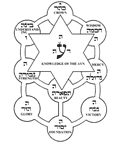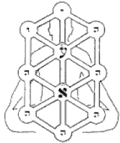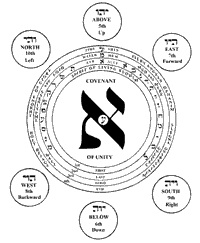




D. The Composition of the Tree of Life
The three columns of the Tree and their respective Sefiroth are said to
emanate from or be anchored in the substratum of the unmanifest, undifferentiated
negatively existent roots. The Central Column emanates from the negatively
existent roots through a single point in the uppermost Sefirah, called "Crown"
in the Zohar and "Above" in the Sefer Yetzirah.
In the initial event at the genesis of the universe, the unmanifest Light
of the Endless enters the Tzimtzum (circular Contraction) through
that point in the supernal World of Atziluth (Emanation), triggering a quantum
fluctuation that generates the Big Bang and subsequent inflation of the
universe. It then descends through the successive three worlds, thereby
manifesting the complete Tree. The Central Column is called the "Line
of Light" (Kav) in the Lurianic doctrine presented in the Etz
Ha Chayyim.
With the expansion of the Tree, the universe is created by the Celestial
Head of Messiah called "The First,"Literally reflected in the first word of Torah B’reshith, tysarb (Buh-Reshith lit. "By the First"). and sustained in the Tree
as a balanced tension between Vast and Small Face.The extension of the Central
Column is precipitated and sustained by the tension between the two Sefiroth
Crown/Above and Foundation/Below, which emanate as a pair of opposites.
The Central Column is said to be a "clear mirror." As the Central
Column extends, the Column of the Right and the Column of the Left manifest
as opposite reflections in the clear mirror of the Central Column. The remaining
Sefiroth emanate as pairs of opposites in the two side columns, and the
four qabalistic worlds manifest as self-consistent planes of existence.
The four qabalistic worlds will be discussed in the next section.

 These three distinct columns play a prominent role in the different ways
the Tree can be ascended. When the spiritual energy (called Shekhinah
in Hebrew and Kundalini or Chitshakti in Sanskrit) awakens,
it ascends the Tree of Life in various ways, expanding and moving the consciousness
through successive planes of existence. Each different path up the Tree
is known as a "Working Tree." The entire spectrum of Trees of
Life is also known collectively as "Angelic or Enochian Tree Language."
Angelic Tree Language consists of various types of "Working Trees"
and "Trees of Perfection" (see
Diagram). Mystics seeking union with the Divine, saints, wizards,
and white and black magicians ascend the Tree through different Sefirothic
patterns. A Working Tree, infused with the power of a suitable Name of God,
mantra, or other invocation, automatically directs the changes in consciousness
of the traveler along its characteristic pattern of gates. Different forms
of the Tree, called "Trees of Perfection" (see
Diagram ), allude to enlightened yogis, transcendent devotees, saints
and Messiah. All the various types of Working Trees and Trees of Perfection
are be presented in the book Qabalah: The
Mystical Heritage of the Children of Abraham.
These three distinct columns play a prominent role in the different ways
the Tree can be ascended. When the spiritual energy (called Shekhinah
in Hebrew and Kundalini or Chitshakti in Sanskrit) awakens,
it ascends the Tree of Life in various ways, expanding and moving the consciousness
through successive planes of existence. Each different path up the Tree
is known as a "Working Tree." The entire spectrum of Trees of
Life is also known collectively as "Angelic or Enochian Tree Language."
Angelic Tree Language consists of various types of "Working Trees"
and "Trees of Perfection" (see
Diagram). Mystics seeking union with the Divine, saints, wizards,
and white and black magicians ascend the Tree through different Sefirothic
patterns. A Working Tree, infused with the power of a suitable Name of God,
mantra, or other invocation, automatically directs the changes in consciousness
of the traveler along its characteristic pattern of gates. Different forms
of the Tree, called "Trees of Perfection" (see
Diagram ), allude to enlightened yogis, transcendent devotees, saints
and Messiah. All the various types of Working Trees and Trees of Perfection
are be presented in the book Qabalah: The
Mystical Heritage of the Children of Abraham.
Fallen and Perfect Trees on the Human Body
The Tree provides the finite intellect with a frame of reference for all
possible experiences. Each Sefirah is itself a complete Tree present in
all planes of existence. The entire Tree, as well as each individual Sefirah,
is therefore an open-ended ladder from the waking state all the way into
the Light of the Endless (Ayn Sof Or). A great secret of the gates
is that they are stationed in the Light of the Endless. Hence, by closing
off both ends of any gate, consciousness automatically expands into the
Light of the Endless. This is why the experience in the gates can be more
unsettling than in the relatively stable and orderly Sefiroth.
 Another significant component of the Tree of Life is called the "Inner
Court." The Inner Court of
the Tree, also known as the "Throne of Glory of El Shadai,"
generally refers to a grouping of four Sefiroth in the center of the Tree
of Perfection. The Inner Court is most clearly seen in the three-dimensional,
double pyramid Trees of the Sefer Yetzirah (see
Diagram) and the Merkabah
literature (see Diagram).
In the Sefer Yetzirah, the four Sefiroth of the Inner Court
are called Spirit of Living Elohim, Air, Water, and Fire; and alternately,
Depth of First, or simply First, (Depth of) Last, (Depth of) Good, and (Depth
of) Evil. In the Zohar, they are the Sefiroth Knowledge, Mercy,
Power, and Beauty. Each set of these four Sefiroth corresponds respectively
with the three Mother Letters Alef, Mem, and Shin, and the letter Tav of
the Holy Temple. In the flat forms of the Tree (see
Diagram ), the Sefirah Mercy/Water moves into the Column of the
Right and Sefirah Power/Fire moves into the Column of the Left.
Another significant component of the Tree of Life is called the "Inner
Court." The Inner Court of
the Tree, also known as the "Throne of Glory of El Shadai,"
generally refers to a grouping of four Sefiroth in the center of the Tree
of Perfection. The Inner Court is most clearly seen in the three-dimensional,
double pyramid Trees of the Sefer Yetzirah (see
Diagram) and the Merkabah
literature (see Diagram).
In the Sefer Yetzirah, the four Sefiroth of the Inner Court
are called Spirit of Living Elohim, Air, Water, and Fire; and alternately,
Depth of First, or simply First, (Depth of) Last, (Depth of) Good, and (Depth
of) Evil. In the Zohar, they are the Sefiroth Knowledge, Mercy,
Power, and Beauty. Each set of these four Sefiroth corresponds respectively
with the three Mother Letters Alef, Mem, and Shin, and the letter Tav of
the Holy Temple. In the flat forms of the Tree (see
Diagram ), the Sefirah Mercy/Water moves into the Column of the
Right and Sefirah Power/Fire moves into the Column of the Left.
The four Sefiroth of the Inner Court are also shown as corresponding to
the four 'Celestial Heads' of Messiah of the Lord YHVH. These four Heads
are functionally instrumental in creating, maintaining, and dissolving the
manifest Small Face universe. In the Sifra Detzniyutha, the
emanation and manifestation of the Sefiroth through the action of the Head
of Messiah called "The First" (Reshith) is described as
Small Face turning outward from Vast Face. On the contrary, when the Small
Face Universe is dissolved by the action of the Head of Messiah called "The
Last" (Acharit)Acharit or Acharon (The Last) is the final and fourth Head of
Messiah. Note: Isaiah 41:4, "I am The First and The Last. I am He (Hu).", the side columns collapse and the Sefiroth return to their unmanifest condition in the roots of the Tree. With the dissolution
of the Small Face universe, the two "Faces" are said to return
to the condition of "seeing Face-to-Face." The four Heads of Messiah
and the nature of the messianic advent of the Lord YHVH will be discussed
more fully in the web page "YHVH
and the Nature of Messianic Appearance."
In addition to the four Sefiroth of the Inner Court, the Tree has six "Directional
Sefiroth." In the Sefer Yetzirah, the six directional
Sefiroth are aptly named "Above, Below, East, West, North and South."
In the Zohar, they are respectively called "Crown, Foundation, Wisdom,
Glory, Understanding, and Victory." In the Merkabah literature, four
of the Directional Sefiroth are correlated with Chayot (Living Beings,
sing. hyx, Chayah), and are also referred to as the "Legs of the Throne."
"And Elohim said the waters will swarm with the movement of
Chayah." (Torah B'reshith 1:20)
"And the Chayot ran and returned as the appearance of a flash of lightning."
(Ezekiel 1:14)
"And out of the midst thereof came the likeness of four Chayot."
(Ezekiel 1:5)
The nature of the Directional Sefiroth is most easily understood in the
three-dimensional Trees, since humans live and move in a three dimensional
space. On the flat Trees, their function with regard to directionality is
less apparent, since such Trees emphasize the three-column structure, and
two of the Inner Court Sefiroth are pulled into the side columns.
In a way, it could be said that the twenty-two letters are the most salient
aspects of the Qabalah. The alphabet is etched deeply in the minds of most
Jews from the time they are children. But while most Jews know the Hebrew
letters, relatively few are aware of their function and nature within the
context of the Qabalah. As mentioned earlier, the most ancient and prolific
source regarding the mystical nature of the individual Hebrew letters is
the Sefer Yetzirah. In the Sefer HaShmoth (Book
of the Names), the letters are seen most prominently as the formulaic
components of Divine Names and within the context of the Angelic Tree Language,
but no further elaboration is given about them. In the Sefer Yetzirah,
on the other hand, the individual letters are introduced in their role as
the infrastructure connecting the ten Sefiroth. They are identified according
to type i.e. Mother, Double, Simple, how they correlate to various aspects
of the human body and to nature, and how they relate to one another. Most
contemporary books on the Jewish Kabbalah and Practical Qabalah assign the
letters to the gates differently than the Sefer Yetzirah,
and often in accordance with the teachings of Luria recorded posthumously
by Vital. Such discrepancies do not necessarily imply a dichotomy of opposing
views, as there is flexibility for setting up the gates on the Tree in different
ways. However, some such patterns can be problematic, and it is generally
recommended to work with the assignations from the Sefer Yeztirah
or Luria.